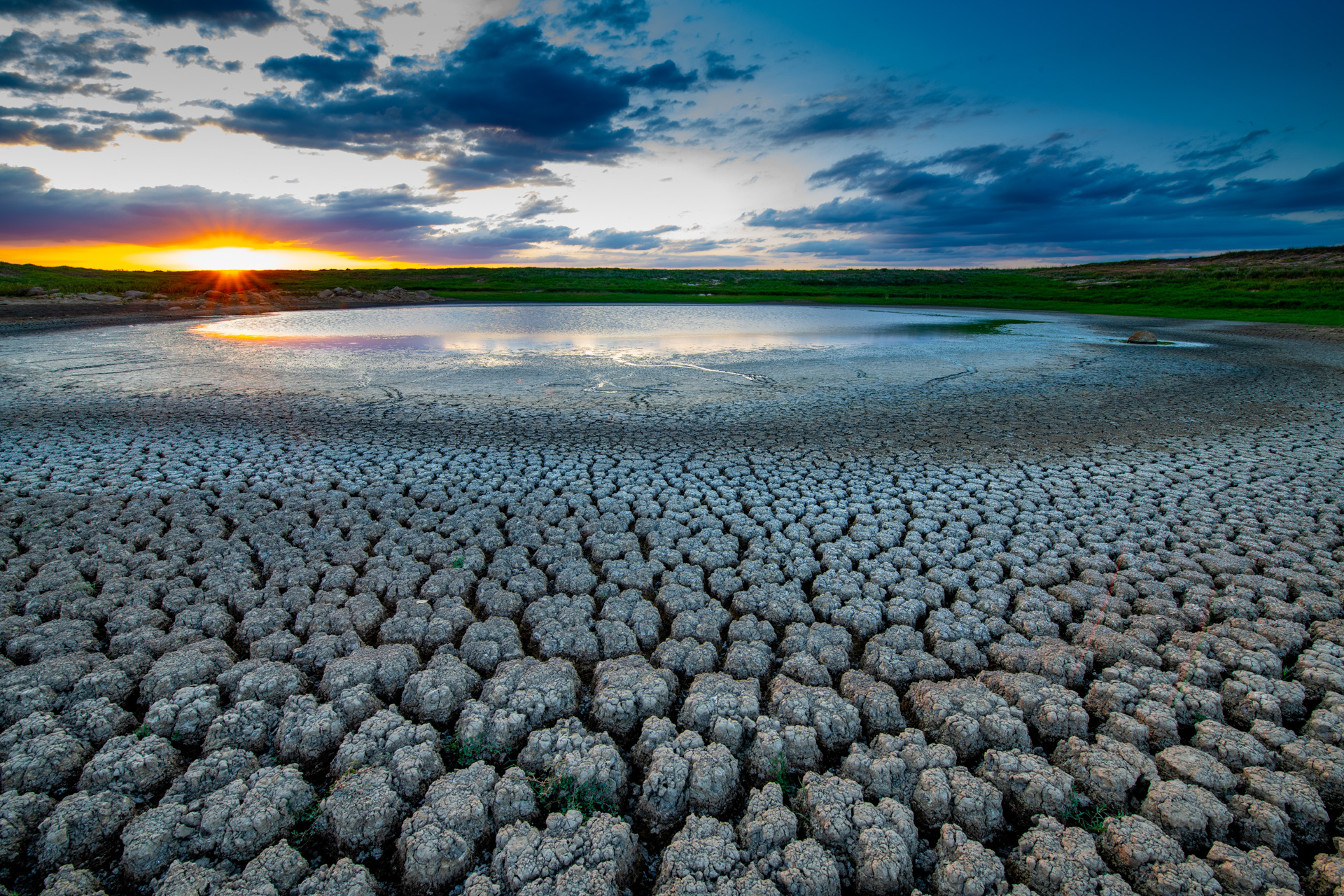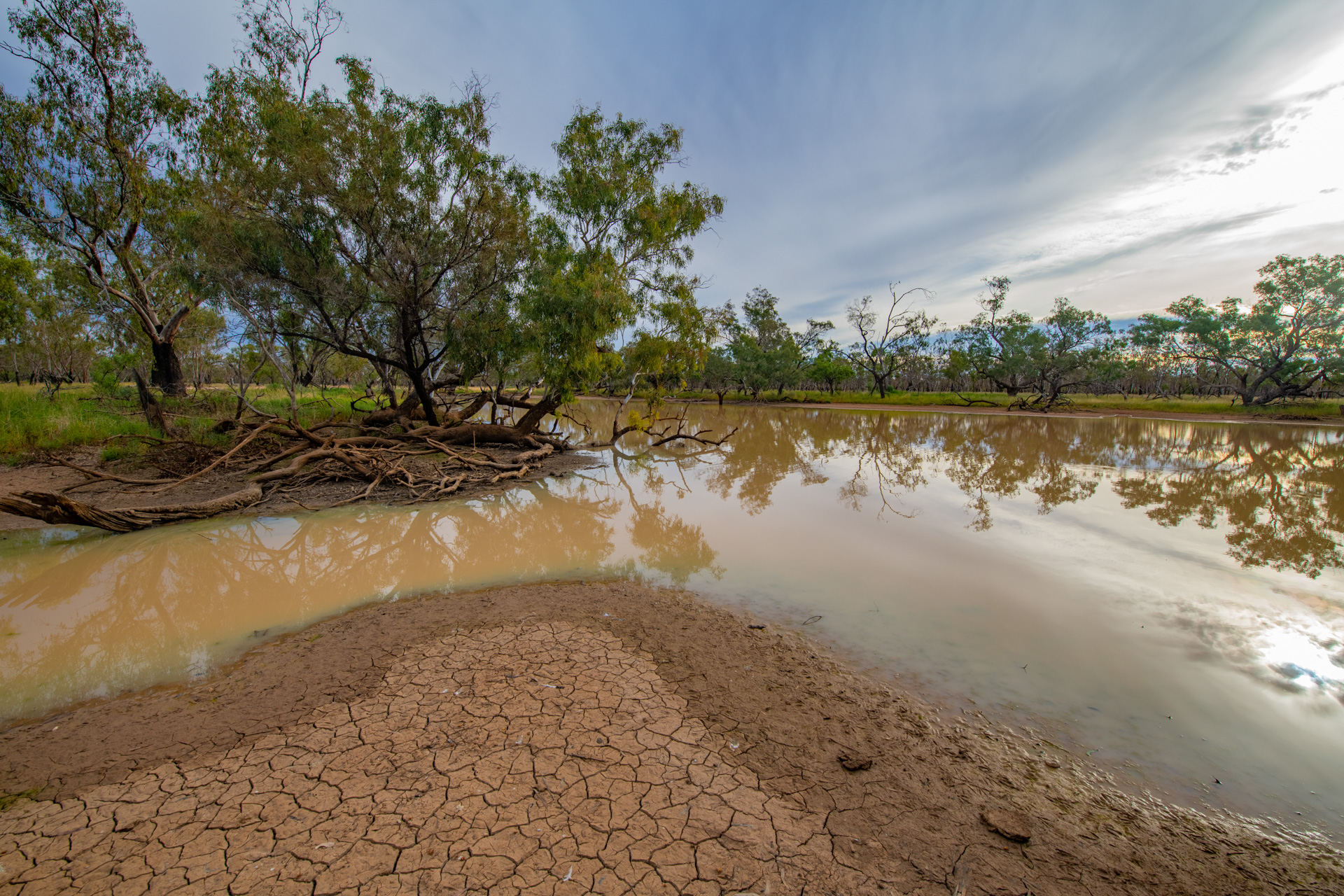|
|
DroughtDrought is a prolonged, abnormal dry period when the amount of water available is insufficient to meet normal use[3]. There are several different types of droughts, including[1]:
Drought is a natural process that is driven by climate/weather cycles and processes. Droughts occur due to complex array of factors including higher than normal surface air temperatures, reduced relative humidity and persistent atmospheric circulation patterns that produce little or no precipitation. In Australia, the El Nino-Southern Oscillation causes cooler ocean temperatures, less evaporation and diminishes the potential for rainfall, particularly over the northern and eastern parts of the country. The Indian Ocean Dipole (IOD) can also impact weather patterns, with positve IOD events being often associated with El Niño, leading to less rainfall over southern Australia and the Northern Territory[2]. River regulation and water extraction can exacerbate hydrological drought and must be managed to ensure that permanent adverse impacts to wetlands and species does not occur. Understanding the environmental flow requirements of wetlands and their species especially under a changing climate is essential to inform government policies. In Queensland, the water in many rivers and other wetlands are intermittent or ephemeral, with flow that is dominated and dependent on direct input and runoff from rainfall, with less of a contribution from base-flow (groundwater) contributions. Such ‘dryland’ systems are susceptible to drying out during meteorological droughts, when rainfall is deficient. Some wetlands, such as the perched and window lakes on K'gari rely on water from both groundwater (perched and regional aquifers) and rainfall. During drought, these lakes provide important drought refugia. However, the level of water tables may fall due to reduced recharge of groundwater, or modifications to the systems can affect water levels. The water deficit experienced by wetlands during drought can reduce the ecosystem services provided by wetlands such as water purification, fish habitat and water storage. However, the drier wetland habitat can become valuable habitat for a wide array of terrestrial invertebrates. Many wetland ecosystems are adapted to drought conditions as can be seen in the boom and bust ecology of the Lake Eyre Basin. During drought, freshwater wetlands may dry out completely and benthic sediments may become airborne due to aeolian processes. Flow may drop in rivers and aquifers and the flushing of lakes may decline. Rivers and streams may dry, creating isolated pools, fragmenting ecological connectivity. Reduction in water levels reduce the habitat available for aquatic species as riffles and pools dry up. During drought, flood events which are required to prompt migration or spawning in rivers or other wetlands can be missed, thereby affecting animal lifecycles over coming seasons or years. Loss of riparian vegetation during droughts may impact aquatic flora and fauna by reducing the cooling effect that shade has on water. This can degrade the condition of aquatic plant species and impact instream fauna e.g., affecting fish spawning and reducing dissolved oxygen concentration. Estuarine wetlands are also impacted by drought. Estuaries experience a fluctuating balance of fresh and salt water. Drought reduces freshwater input from rivers and streams into estuaries and bays which along with evaporation, raises salinity and enables saltwater to mix farther upstream with potential impacts on ecosystem health. Reduced freshwater input to estuaries also reduces sediment and nutrient loads. With less nutrients there is less primary production which results in less food in the water column and on benthic habitats (mudflats and sandflats). This may impact on recruitment and growth of biota. Low freshwater inputs can also alter the hydrodynamics of estuaries by reducing the vertical mixing in the water column and reduced flushing. This results in the retention of sediments and nutrients, which can eutrophy the water, leading to phytoplankton blooms, and lowering dissolved oxygen levels, which results in fish kills. Reduced flows also decrease sediment scouring at the mouth and along the banks of the estuary which can lead to formation of sandbar barriers to migration for aquatic fauna. Wetlands provide valuable refugia for species that lack adaptations to drought, providing places to retreat to, persist in and potentially expand from post drought. A wide variety of specific habitat types have been identified as a critical refugia for freshwater biodiversity including the hyporheic zone, the riparian zone, instream woody debris, sandbars and rock crevices. For arid and semi-arid regions of Australia, permanent waterholes provide aquatic refuges during hydrological drought when flow is low or non-existent. The conservation of freshwater refugia is considered essential in the face of climate change. Some wetlands may be home to species that are adapted to drought relying on periodic drought for part of their lifecycles and/or have strategies that enable them to exploit drier conditions. Dry riverbeds provide a unique habitat for terrestrial invertebrates including ants, beetles, springtails, mites, flies, bugs, cockroaches, and spiders. Amphibians for example, may benefit as drought can reduce the number of predators available to prey on tadpoles. Macroinvertebrates that inhabit dryland wetlands have adaptations ranging from behavioural, such as burrowing and dispersal to morphological and physiological adaptations such as resistance to desiccation and capacity to undertake aerial respiration. Dryland wetlands (when dry) also provide habitat for drought tolerant plant species and/or plant species that re-establish easily when wet conditions return, e.g., grasses and reeds can die-off but regenerate on re-wetting from soil seed and rhizome banks that remain viable for long periods. Additionally, trees survive drought through senescence of leaves and branches to minimise loss of water from evapotranspiration and water use respectively. Droughts may also inhibit invasive species from establishing in wetlands. Links and referencesAbout Drought (n.d.), Wetlands Report Card 2020, United Kingdom, Viewed 14/8/23, PowerPoint Presentation Aspin TWH, Khamis K, Matthews TJ, Milner AM, O'Callaghan MJ, Trimmer M, Woodward G, Ledger ME. Extreme drought pushes stream invertebrate communities over functional thresholds. Glob Chang Biol. 2019 Jan;25(1):230-244. doi: 10.1111/gcb.14495. Epub 2018 Nov 14. PMID: 30346098; PMCID: PMC7379955. Barr, C., Tibby, J., Marshall, J.C., McGregor, G.B., Moss, P.T., Halverson, G.P., and Fluin, J. (2013), Combining monitoring, models and paleolimnology to assess ecosystem response to environmental change at monthly to millennial timescales: the stability of Blue Lake, North Strabroke Island, Freshwater Biology, Vol 58, Issue 8, https://onlinelibrary.wiley.com/doi/10.1111/fwb.12154 BOM (n.d.), Climate Glossary, Commonwealth of Australia, Viewed 14/08/23, Climate Glossary - Drought BOM (n.d.), Understanding Drought, Viewed 14/08/23, Understanding drought Burford MA, Faggotter SJ (2021). Comparing the importance of freshwater flows driving primary production in three tropical estuaries. Marine Pollution Bulletin 169, 112565 Capon, S.J. (2003), Plant community responses to wetting and drying in a large arid floodplain. River Res. Applic., 19: 509-520. Chilton, D., Hamilton, D.P., Nagelkerken, I., Cook, P., Hipsey, M.R., Reid, R., Sheaves, M., Waltham, N.J., and Brookes, J. (2021), Environmental Flow Requirements of Estuaries: Providing Resilience to Current and Future Climate and Direct Anthropogenic Changes, Frontiers Environmental Science, Volume 9, https://onlinelibrary.wiley.com/doi/10.1002/rra.730 Department of Environment and Science, Queensland (2013) Riverine ecology (Freshwater Biogeographic Provinces), WetlandInfo website, accessed 14 August 2023. Available at: https://wetlandinfo.des.qld.gov.au/wetlands/ecology/aquatic-ecosystems-natural/riverine/ Gilbert, S., Lckstrom, K., and Tufford, D. (20120, The Impacts of Drought on Coastal Ecosystems in the Carolinas, Carolinas Integrated Sciences and Assessments, Viewed 14/08/23 Gillanders, B.M., Elsdon, T.S., Halliday, I.A., Jenkins, G.P., Robins, J.B., Valesini. F.J. (2011), Marine and Freshwater Research, 62, 1115-1131. James, CS, VanDerWal, J, Capon, SJ, Hodgson, L, Waltham, N, Ward, DP, Anderson, BJ & Pearson, RG 2013, Identifying climate refuges for freshwater biodiversity across Australia, National Climate Change Adaptation Research Facility, Gold Coast, 424 pp. Marshall JC, Sheldon F, Thoms MC, Choy S (2006). The macroinvertebrate fauna of an Australian dryland river: Spatial and temporal patterns and environmental relationships. Marine and Freshwater Research 57, 61–74. doi:10.1071/MF05021 1323-1650/06/010061 Marshall, J.C., Lobgeiger, J.S., Starkey, A., Hodges, K. (n.d.), Risks to fish populations in Australian dryland rivers from the combined threats of drought and loss of connectivity, Viewed 14/08/23, Risks to fish populations in dryland rivers from combined threats of drought and connectivity loss - YouTube Marshall, J., Sheldon, F., Thoms, M., & Choy, S (2006). The macroinvertebrate fauna of an Australian dryland river: spatial and temporal patterns and environmental relationships. Marine and Freshwater Research. 5. 61-74. 10.1071/MF05021 McNab, A.L., and Karl, T.R., (n.d.), Climate and Droughts, National Oceanic and Atmospheric Administration, USA, Viewed 14/08/23 NIDIS (n.d.), Drought Basics, USA Government, viewed 14/08/23 NSW Government (n.d.), Hypoxic blackwater, Viewed 14/08/23 Palmer, T.A., Montagna, P.A. Impacts of droughts and low flows on estuarine water quality and benthic fauna. Hydrobiologia 753, 111–129 (2015). https://doi.org/10.1007/s10750-015-2200-x Sandi, S.G., Rodriguez, J.F., Saintilan, N. et al. Resilience to drought of dryland wetlands threatened by climate change. Sci Rep 10, 13232 (2020). https://doi.org/10.1038/s41598-020-70087-x Steward AL, Marshall JC, Sheldon F, Harch B, Choy S, Bunn SE, Tockner K (2011). Terrestrial invertebrates of dry river beds are not simply subsets of riparian assemblages. Aquatic Sciences 73, 551–566 E. Stirling, R.W. Fitzpatrick, L.M. Mosley (2020), Drought effects on wet soils in inland wetlands and peatlands, Earth-Science Reviews, Volume 210 Tyler, J.J., Marshall, J.C., Schulz, C., Barr., C., Hofmann, H., Blessing, J.J., McCoy, K., McGregor, G.B. and Tibby, J. (2022), Hydrological and Isotopic Variability of Perched wetlands on North Stradbroke Island (Minjerribah), Australia: Implications for Understanding the Effects of Past and Future Climate Change, Frontiers Environmental Science, Volume 10 References
Last updated: 17 October 2023 This page should be cited as: Department of Environment, Science and Innovation, Queensland (2023) Drought, WetlandInfo website, accessed 25 June 2024. Available at: https://wetlandinfo.des.qld.gov.au/wetlands/ecology/processes-systems/drought/ |

 — Department of Environment, Science and Innovation
— Department of Environment, Science and Innovation



